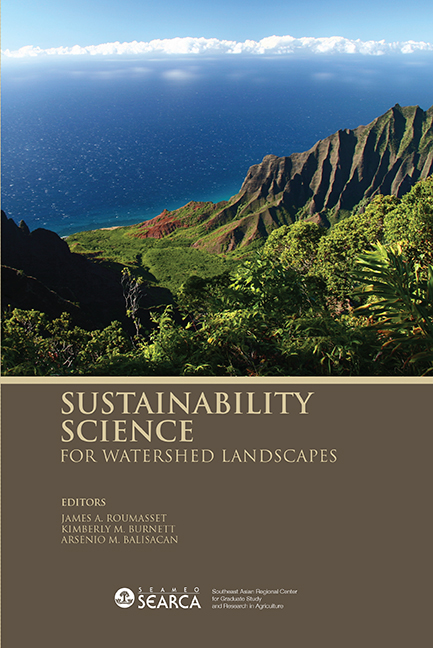Preface
Published online by Cambridge University Press: 21 October 2015
Summary
Globally, we must confront our inability to meet the demands of unchecked population growth, rapid depletion of natural resources, increasing energy needs, and the world-wide deterioration of aquatic and terrestrial ecosystems. In short, the current behaviour of humans on this planet is not sustainable.
In August of 2006, the University of Hawaiʿi at Mānoa (UHM) signed a Memorandum of Understanding with the Southeast Asian Regional Center for Graduate Study and Research in Agriculture (SEARCA). The goal of the UHMSEARCA initiative was to synthesise a third wave in sustainability science that goes beyond the nature of interactions in order to facilitate policy analysis. The resulting “International Conference on Sustainability Science for Watershed Landscapes,” held on November 13-14, 2007, was a product of that collaboration and with the East-West Center. One of the major accomplishments of that conference is this reference volume on methods and applications in both Hawaiʿi and Asia.
In 2008, a Mānoa Ad Hoc Committee of Faculty and Administrators proposed the organisation of an Institute of Sustainability Science, Technology and Policy. The mission they articulated was to apply the knowledge and talents of the University to the practical problems that our society faces in supplying ourselves with the resources of energy, water, food that a growing population requires from a diminishing resource base. Specifically, they suggested that the Institute would build on the vision of sustainability science, a transdisciplinary method of organising research to deliver meaningful contributions to critical issues of resource management and rigorous policy analysis.
With this effort the University of Hawaiʿi joins many other universities in North America and Asia in leading the efforts to take us beyond sustainability. After all, it will not be enough to just sustain the current situation. Sustainability science offers a way of organising research to deliver practical solutions based on integrated and scientifically sound research.
In closing, I both congratulate and thank the authors of the ensuing chapters for their efforts to stimulate the sustainability science movement and facilitate further collaboration between East and West.
- Type
- Chapter
- Information
- Publisher: ISEAS–Yusof Ishak InstitutePrint publication year: 2010

